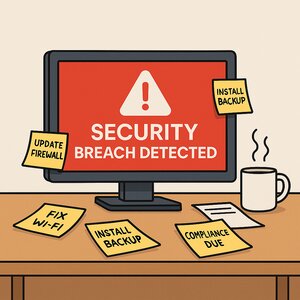It’s easy to overlook IT and cybersecurity when juggling multiple priorities, especially in a small business. Yet, ignoring these areas can lead to breaches, downtime, and costly fines—often crippling companies overnight. After working with businesses of all sizes, here are the most damaging mistakes I see time and again.

1. Treating IT and Cybersecurity as an Afterthought
Many owners react to IT or security issues only when something goes wrong, underestimating how rapidly threats evolve. A single ransomware attack can shut down your entire operation, resulting in lost revenue and damaged customer trust. By thinking long-term and investing in proactive measures, you’ll avoid disruptions and prevent expensive emergency fixes.
2. Relying on Cheap or Free Tools
Consumer-grade routers and free antivirus software might seem like a cost-effective choice, but they rarely stand up to sophisticated threats. If you wouldn’t trust a free spreadsheet app to manage your finances, why gamble with free security software for your business? Proper IT solutions designed for professional environments offer stronger defenses, helping you stay ahead of hackers.
3. Ignoring the True Cost of Downtime
It’s tempting to believe a few hours offline won’t hurt. But consider how many tasks rely on your IT systems: emails, customer orders, collaboration tools, accounting software, and more. Extended downtime not only stalls productivity but also damages client relationships and your bottom line. A robust IT strategy is about continuity—keeping your systems up and running, no matter what.
4. Failing to Plan for the Long Game
Cyber threats, software vulnerabilities, and compliance requirements change rapidly. Security isn’t a set-it-and-forget-it project; it’s an ongoing commitment to monitoring, updates, and staff training. By continually reassessing your security posture, you’ll maintain a strategic edge and avoid playing catch-up after a breach.
Q&A: Best Way to Reduce Cybersecurity Risks for SMBs?
Common Question: “What’s the best way to reduce cybersecurity risks in a small business environment?”
Short Answer: Begin with a thorough risk assessment completed by a professional to identify weak points. Create a roadmap with a Senior IT Specialist. Example: Implement layered defenses, from firewalls to endpoint protection and regular software updates. Next plan technical safeguards with employee awareness training, and meet quarterly to keep your strategy current as threats evolve.
How Entech Helps You Avoid These Mistakes
Building a cybersecurity response plan can be complex, but you don’t have to do it alone. At Entech, we specialize in proactive IT solutions that evolve with your business. Our approach protects your data, minimizes downtime, and ensures your technology aligns with your business goals.
Next Steps:
If you’re ready to ditch band-aid fixes and take IT seriously, schedule 10-minutes to discuss the FREE Security Assessment. You’ll speak with a real Entech expert—no pressure, no hard sales pitch—to explore how to better safeguard your operations.
“We make IT work for you.”